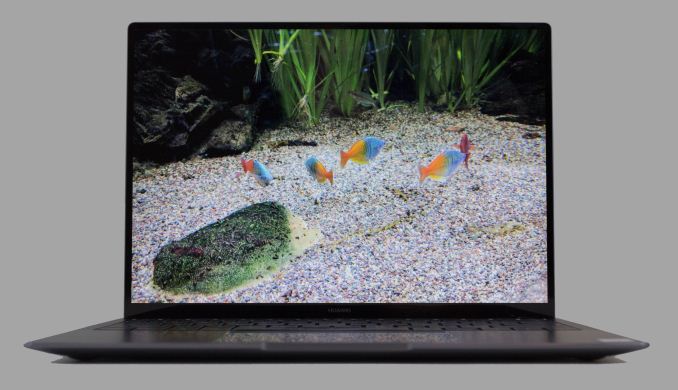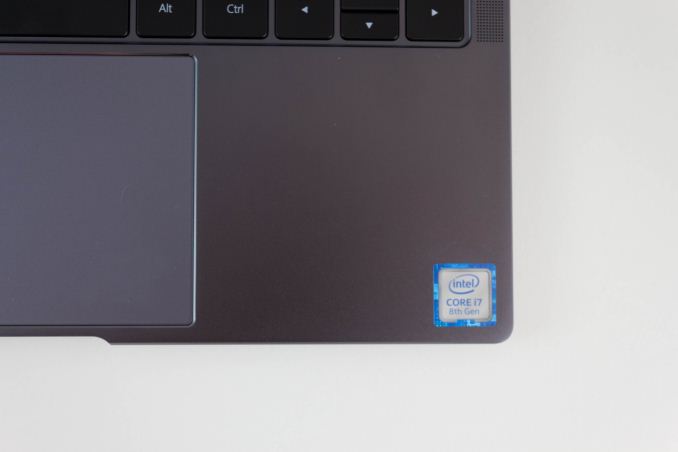The Huawei MateBook X Pro Review: Calling Out The Competition
by Brett Howse on June 27, 2018 8:00 AM EST
Huawei has not been in the PC game very long, but in just a short couple of years they certainly raised the bar for the competition in the Ultrabook category. Today we’re taking a look at the latest Huawei MateBook X Pro, and with this release, the traditional PC makers need to stand up and take notice.
The MateBook X Pro features a laundry list of features you’d look for in a new Ultrabook. The PC world has fully embraced the thin-bezel revolution, and Huawei has taken this to an impressive 91% screen to body ratio on their latest Ultrabook, which features just 4.4 mm bezels all the way around. The small jump from the previous generation’s 88% was achieved by relocating the webcam to the keyboard, which we’ll cover later. In addition to the thin bezels, Huawei has kept the fantastic 3:2 aspect ratio display as the MateBook X, but increases the display size and resolution, to 13.9-inches and 3000x2000 respectively.
The laptop offers pretty much every feature you could hope for in thin and light Ultrabook, with Intel’s 8th generation Core U series processors in the i5-8250U and i7-8550U, both of which are Kaby Lake Refresh with four cores and eight threads. The Core i7 model also comes with NIVIDIA’s GeForce MX150 GPU, with 2 GB of GDDR5 and 384 CUDA cores, which should offer substantially more grunt than the Intel HD 630. RAM is 8 GB of the Core i5 and 16 GB of LPDDR3 on the Core i7, which is the maximum amount of LPDDR3 you can fit in a U series laptop.
| Huawei Matebook X Pro (2018) | |||
| Core i7 With MX 150 (model reviewed) |
Core i5 Without MX 150 |
||
| Processor | CPU | Intel Core i7-8550U | Intel Core i5-8250U |
| Cores | Quad Core with HT | Quad Core with HT | |
| Base Freq | 1.8 GHz | 1.6 GHz | |
| Turbo Freq | 4.0 GHz | 3.6 GHz | |
| L3 Cache | 8 MB | 6 MB | |
| TDP | PL1 = 15W | PL1 = 15W | |
| Graphics | NVIDIA MX150 2GB GDDR5 384 CUDA Cores |
Intel HD 630 24 EUs 300-1100 MHz |
|
| Display | 13.9-inch 3000x2000 LTPS 100% sRGB 450 nits 1500:1 contrast ratio 10-point touch |
||
| DRAM | 16 GB LPDDR3 | 8 GB LPDDR3 | |
| Storage | 512 GB NVMe PCIe 3.0 x 4 |
256 GB NVMe PCIe 3.0 x 4 |
|
| Wireless | Intel Dual Band Wireless-AC 8275 802.11ac 2x2:2 Dual Band |
||
| Connectivity | 1 x Type-C (Power and Data) 1 x TB3 (Power and Data) 1 x Type-A 3.5mm TRRS |
||
| Camera | Spring Latch 1MP |
||
| Battery | 57.4 Wh | ||
| Dimensions | H x W x D | 304 x 217 x 14.6 mm | |
| Mass | ~1.33 kg | < 1.33 kg | |
| Price | $1499.99 USD | $1199.99 USD | |
But the fun hasn’t stopped there. Huawei has also outfitted the MateBook X Pro with two USB-C ports which both support power and data, and one of them is also Thunderbolt 3 enabled. For those that still need access to normal USB, which is most people, there’s also a USB-A port as well. There’s no SD card slot, which would be the one thing that might be missed, but it’s a small sacrifice.
The MateBook X Pro also ships with the Intel Dual Band Wireless-AC 8265 network adapter, which is a 2x2:2 adapter with 80 MHz channels, meaning a maximum connection speed of 867 Mbps, and integrated Bluetooth 4.2. Since Intel added MU-MIMO support, it’s easily the adapter of choice with great performance and high reliability.
Huawei has managed to pack in pretty much everything you could wish for in an Ultrabook, but they’ve still kept a thin and light design which we’ll take a look at now.











77 Comments
View All Comments
Brett Howse - Thursday, July 5, 2018 - link
It does have Touch support. Sorry I meant to have that listed in the spec table. I've added it now.dr.denton - Wednesday, July 11, 2018 - link
Did I just miss it, or was there no mention of the inherent differences between a fully integrated APU and a CPU+GPU+dedicated graphics memory? To be honest, I don't find it particularly impressive to outperform a 15W R7 with a setup that surely is allowed more power budget, has more memory bandwidth and, I assume, is more expensive to manufacture.s.yu - Saturday, July 21, 2018 - link
Yup, this review is fairly disappointing, it's not as detailed as Notebookcheck's. Sometimes Anandtech does a better job but not this time.s.yu - Saturday, July 21, 2018 - link
This feels like an ad, why on earth is the base model's $1500 "undeniable value", as an ultrabook there's hardly anything of note besides the screen's brightness and resolution(sRGB coverage is basically standard for any ultrabook other than the cheapest, touch is also pretty common). The SSD is triple sourced and you can bet on the other variants to be slower, this speed is typically only seen in mid-high tier Samsungs, I've never seen Toshibas reach this speed for example. The thunderbolt is only two lanes, old problem, while Dell is already moving to fix that. Overall lack of ports for what's supposed to be a more pro-oriented model (they added the MX150, if only the slow version). No Windows hello? Xiaomi's new notebook among others are priced much more competitively for the specs.And the design is really mediocre, the up and down arrow keys for example should be full size, or the left and right should be half sized, as of now the pressure points of the side keys and the down key aren't in a straight line, I've tried such a keyboard before and was very annoyed by the differently sized arrow keys. The webcam placement is downplayed but its angle is even worse than the XPS solution, because it's closer to the user, also because it would be completely unusable on a stand/base commonly used to increase the number of ports and/or improve typing and screen-viewing comfort. From an aesthetic point of view it's also mediocre, choosing a somewhat dated roundish Macbook design (the recent design trend goes bolder, not only the Macbooks but also new XPSs and the new Blade follow this trend, even Xiaomi) and slapping a Huawei logo onto it.
RaymondIT - Tuesday, July 24, 2018 - link
I still don't see why a higher end system like this is using slower memory that takes more power. LPDDR4 or even DDR4 would be a better choice. LPDDR4 uses 40% less power??Joiiyrancher - Monday, October 8, 2018 - link
Did you guys ever look into the reports that the thunderbolt 3 ports only provided 2 Lane support and therefore significantly compromised eGPU p performance? I think notebookcheck wrote about it. If that isn't the case I would buy one today.